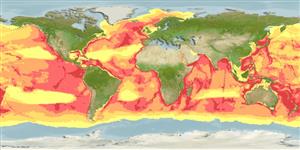Common names from other countries
Environment: milieu / climate zone / depth range / distribution range
Ecología
Pelágico; no migratorio (Ref. 75906); rango de profundidad 0 - 1989 m (Ref. 116169). Deep-water; 90°N - 90°S, 180°W - 180°E
Atlantic Ocean and Indo-Pacific. Tropical to warm temperate zones.
Length at first maturity / Tamaño / Peso / Age
Maturity: Lm ?, range 270 - 280 cm Max length : 340 cm TL macho / no sexado; (Ref. 1394); peso máximo publicado: 400.0 kg (Ref. 1394)
Commonly seen over and near the continental slope. Feeds on deep-water cephalopods, fish and shrimps (Ref. 936).
Tan, J.M.L. 1995. (Ref. 936)
IUCN Red List Status (Ref. 130435)
CITES status (Ref. 108899)
Not Evaluated
Human uses
Pesquerías: comercial
FAO - pesquerías: landings, species profile | FishSource | Sea Around Us
Herramientas
Más información
Age/SizeCrecimientoLength-weightLength-lengthMorfologíaLarvaAbundancia
Fuentes de Internet
Estimates based on models
Preferred temperature
(Ref.
115969): 2 - 13.7, mean 4.5 (based on 2235 cells).
Vulnerability
Very high vulnerability (90 of 100).
Price category
Unknown.
